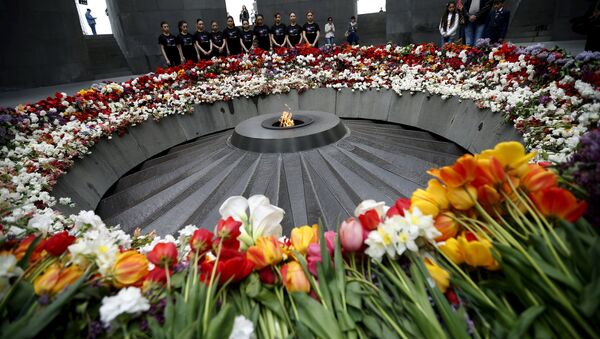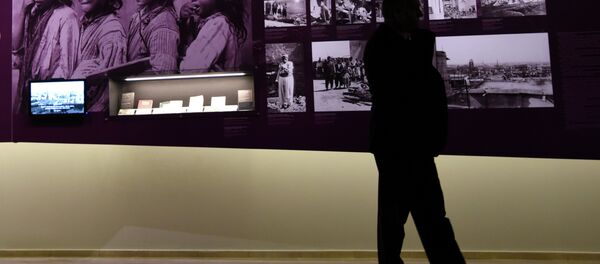MOSCOW (Sputnik) — Armenians across the entire world on Friday hold commemorations marking the centenary of the Armenian massacre by Ottoman authorities.
24 апреля день памяти жертв геноцида армян. #ArmenianGenocide pic.twitter.com/VJlrOJ3Tp5
— маша березина (@masha_1589) 24 апреля 2015
The massacre took place on the territories of the Ottoman Empire, the predecessor of present-day Turkey, that were historically called Western Armenia, now Eastern Anatolia, and were inhabited predominantly by Armenians. Their annihilation was part of the Ottoman Empire's policy based on its ideology of Pan-Turkism and intolerance of non-Turkic people.
Most Tragic Page of Armenian History
Historians split the genocide into two stages. During the first stage (1878-1914), the task was to retain the territory of the enslaved people and engineer their exodus, whereas by the second stage (1915-1922), the main goal was to destroy the ethnic and political Armenian population.
The initial strength of the population residing in the Ottoman Empire at that time is disputable because most archives were destroyed. But it is a known fact that in the mid-19th century non-Muslims amounted to more than half of the empire's population.
The Young Turks political group that came to power after the 1908 revolution continued the crackdown on the Armenian national liberation movement. They launched a campaign of forced Turkization and banned non-Turkish organizations.
In 1909, the Young Turks ordered the killings of about 30,000 people – including Armenians, Greeks, and Syrians – in Adana and Aleppo, in what became known as the Kilikya Massacre.
Honor & Respect For Those That Were Brutally Murdered During The 1915 #ArmenianGenocide pic.twitter.com/uoGBdPpiJT
— R Z (@rostomzavarian) 16 апреля 2015
On April 24, 1915, a day now observed as the Armenian Genocide Remembrance Day, mass-scale arrests of Armenian intellectuals, and representatives of the religious, economic and political elites were launched in Constantinople, now Istanbul.
Massacres and deportations of Armenians from Western Armenia started in May-June 1915. Armenians were expelled to deserts, killed by marauders or died of hunger and thirst.
It is our duty to not turn our back, or act in defiance of the tragic reality of a historical fact #ArmenianGenocide pic.twitter.com/ZvajTtznuS
— Nicos Anastasiades (@AnastasiadesCY) 24 апреля 2015
During the final act of deportation on June 21, 1915, its main inspirer, Minister of the Interior of the Ottoman Empire Mehmet Talaat Pasha ordered the expulsion of "all Armenians without exception" from ten provinces in the east of the country, save those who were considered useful to the state.
Smyrna was the last surviving compact Armenian community and with its destruction the Armenian population of the Ottoman Empire practically ceased to exist in its historical land. Survivors sought refuge all over the world, forming diasporas in dozens of countries.
Current estimates of the genocide's toll vary from 200,000, according to some Turkish sources, to over two million. The majority of historians put it between one and one and a half million.
International Recognition of Armenian Genocide
For many years, Armenians all over the world have insisted that the international community should recognize the fact of the genocide officially and without any reservations.
Visit to #Yerevan: Attending memorial events marking 100 years since the Armenian genocide http://t.co/w4Hw86UkLL pic.twitter.com/QY5t5eVJOo
— President of Russia (@KremlinRussia_E) 24 апреля 2015
Uruguay was the first to adopt a special decree in 1965 recognizing and denouncing the 1915 massacre. More laws and resolutions were subsequently passed by the European Parliament, Russia, Cyprus, Argentina, Canada, Greece, Lebanon, Belgium, France, Sweden, Switzerland, Slovakia, the Netherlands, Poland, Germany, Venezuela, Lithuania, Chile, Bolivia and the Vatican.
The United States has formally recognized the annihilation of 1.5 million Armenians in the Ottoman Empire as a historical fact but refuses to qualify it as genocide.
Recognition of the genocide remains one of the main obstacles to normalization of relations between Armenia and Turkey. They have not established diplomatic relations up to this day, and their common border has been shut down since 1993 at Ankara's initiative.
Turkey rejects the existence of the Armenian genocide, maintaining that both Armenians and Turks perished in the 1915 tragedy, and is extremely sensitive on the issue of international recognition of the Armenian genocide in the Ottoman Empire.







